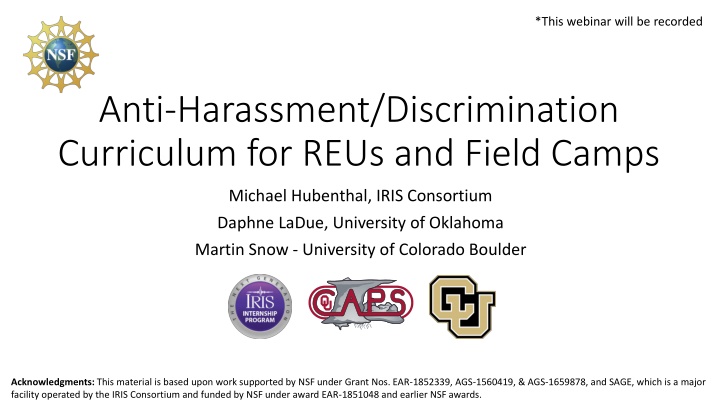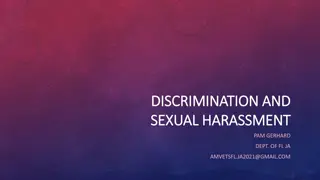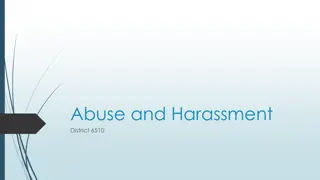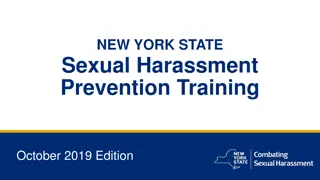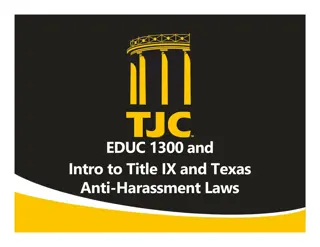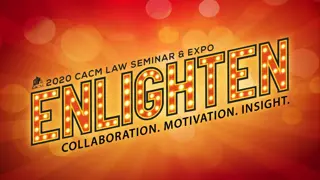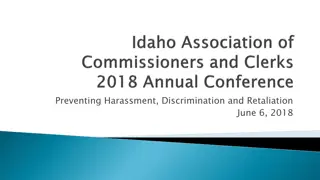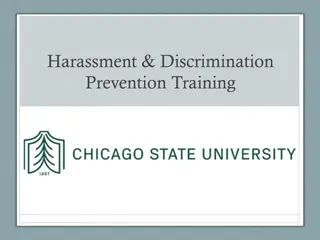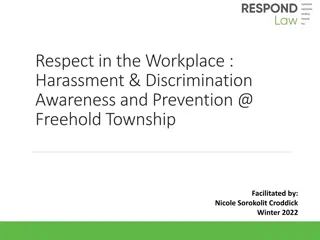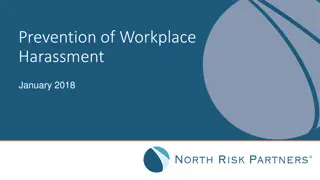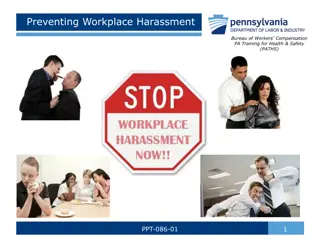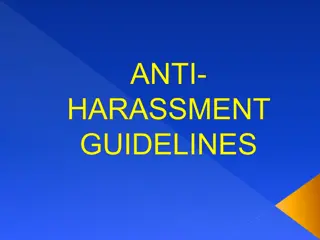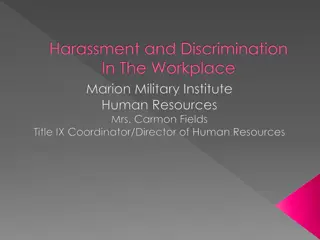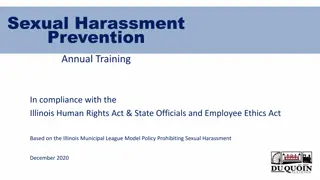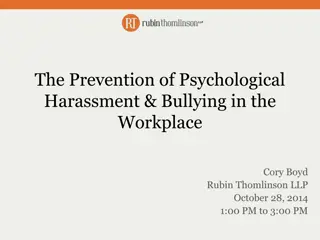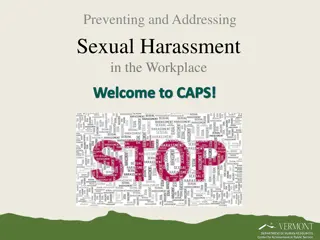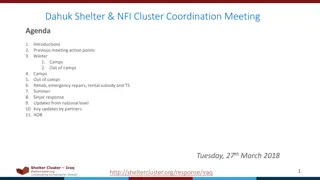Anti-Harassment/Discrimination Curriculum for REUs and Field Camps
This curriculum addresses the need to educate individuals in REU programs on recognizing, responding to, and reporting harassment and discrimination. It emphasizes interactivity and practical resources to foster a culture of change in scientific workplaces. The material is supported by NSF grants and provides valuable insights from expert reviews and student responses. Motivations behind the curriculum include raising awareness of misconduct reporting mechanisms and vulnerability of REU participants.
Download Presentation

Please find below an Image/Link to download the presentation.
The content on the website is provided AS IS for your information and personal use only. It may not be sold, licensed, or shared on other websites without obtaining consent from the author.If you encounter any issues during the download, it is possible that the publisher has removed the file from their server.
You are allowed to download the files provided on this website for personal or commercial use, subject to the condition that they are used lawfully. All files are the property of their respective owners.
The content on the website is provided AS IS for your information and personal use only. It may not be sold, licensed, or shared on other websites without obtaining consent from the author.
E N D
Presentation Transcript
*This webinar will be recorded Anti-Harassment/Discrimination Curriculum for REUs and Field Camps Michael Hubenthal, IRIS Consortium Daphne LaDue, University of Oklahoma Martin Snow - University of Colorado Boulder Acknowledgments: This material is based upon work supported by NSF under Grant Nos. EAR-1852339, AGS-1560419, & AGS-1659878, and SAGE, which is a major facility operated by the IRIS Consortium and funded by NSF under award EAR-1851048 and earlier NSF awards.
Summer 2019 Pilot Summer 2019 Pilot Expert Review Expert Review Reviewer 1 2 3 Do you feel there is a need for this type of resource for REU sites? Why/why not? Yes Yes Yes Would you use this curriculum with your REU participants? Why or why not? Yes Yes Yes Would you recommend this curriculum to other REU PIs? Why or why not? Yes Yes Yes Summarized comments: Appreciated interactivity of the curriculum Provides a great baseline to begin discussions with students Opportunities to expand or adapt Increase the emphasis on microaggressions as these affect the retention of underrepresented groups. It would be helpful to have a best practices for writing a policy manual
Summer 2019 Pilot Summer 2019 Pilot Student Responses Student Responses Demographics The curriculum regarding this subject was eye-opening to the number of forms it can appear in. I enjoyed the fact it was not just here is harassment, it made us draw from our experiences. Perceptions The 'what to do,' was very helpful. Explaining how to report and how to help someone else was helpful. I think the interactiveness was the most positive part of seminar that we did. The focus on personal issues helps to hit home with people more than just sitting in a space and being lectured for an hour about a topic. https://www.iris.edu/hq/internship/images/uploads/Files/AntiHarass_2019_AGU_Poster.pdf
Motivations Motivations Alarming rates of discriminatory and harassing behavior (of all kinds!) in the scientific workplace Few individuals are aware of the mechanisms to report misconduct should they witness it or experience it Participants in REU programs may be uniquely vulnerable A desire to educate students in how to recognize, respond to, and report situations they may experience or witness, and a lack of existing resources to do it. The need to demonstrate the organizational importance of these issues and policies REU PIs need practical resources to enable them to work to address many of the aforementioned issues and contribute to a culture of change. (Clancy et al., 2014)
Curriculum Overview Curriculum Overview Audience: Undergraduate students participating in science, technology, engineering, or math summer research opportunities, or participating in short duration field campaigns such as geoscience field camps, etc. Total Time = ~120 minutes (in person) Session 1 - ~75 minutes Session 2 - 30 to 60 minutes Instructors = 2 are strongly recommended
Curriculum Overview Item Description Prior to starting Open (15 20 min) Safe space, resources, etc. Discussion of literature-based data and anonymous survey Prior Knowledge (20 22 min) Explore / Explain (35 min) Keyword Pictionary and consensus definition construction Whole group discussion of terms and small group work to discuss the scenario in light of key info in program handbook policies Reflect (35 min) Whole group discussion of how do I fit in? Bystander intervention Apply (15 18 min) Putting it all together. Video clip and discussion.
Following instruction, participants will be able to: Following instruction, participants will be able to: Describe a work environment that consists of mutual respect, promotes respectful and congenial relationships, and is free from all forms of harassment and discrimination Summarize who is responsible for creating the work environment described above Distinguish between behavior that is or is not harassing or discriminating. Describe how to report harassment or discrimination to the program, the program s investigation procedures, and possible disciplinary outcomes Plan how they would use the bystander interventions to respond to incidents of discrimination or harassment Apply the program s anti-harassment, anti-discrimination, and non-fraternization policy to a series of case studies
Prior to Instruction Prior to Instruction Develop a program handbook that addresses issues of harassment and discrimination. Your program may fall under your campus guidelines. Explore what what sorts of mental health resources are available on your campus or location for students. To whom can you refer them in order to receive help of they are struggling? How do you/they make those connections? Consider attending a Mental Health First Aid Training
Safe Space* Safe Space* Respect confidentiality. The discussion (comments, stories, and perspectives) shared at meetings should remain private. Lean into the work. Some topics may be challenging. Be willing to experience some discomfort in discussions, and learn from it as a cohort. Use I statements. Speak from your own experience rather than generalizing. Listen. Listen actively by respecting others when they are talking, and respectfully by listening even if you disagree Step Up, Step Back.Encourage participants who don t talk much to step up (speak up, participate), and those who participate a lot to step back (say less) to make room for everyone to contribute Criticize the ideas, not the person. Aristotle said "It is the mark of an educated mind to be able to entertain a thought without accepting it." We can agree to disagree.
What to do if a participant is struggling? What to do if a participant is struggling? Participants should feel free to step out of the discussion at any time should they feel uncomfortable. Have a plan in place to allow you or a member of your team to step out and check on the participant. Listen non-judgementally and give reassurance Who are their regular supports and how can you connect them to those supports? If necessary connect to other resources on campus or in the community
O Open - (15 - 20 Minutes) Discussion of literature-based data and anonymous survey Which of the following most closely to applies to you? Never witnessed discrimination or harassment and never heard of someone who experienced it Heard of someone who experienced discrimination or harassment but never witnessed it Witnessed discrimination or harassment Experience discrimination or harassment (Clancy et al., 2014) Illustrate that discrimination/harassment is not a theoretical construct represented only in articles or a handbook. Reflect on and discuss within their group.
P Prior Knowledge - (20 - 22 Minutes) Keyword Pictionary and consensus definition construction Harassment Illegal Flirting Mutual respect Unwanted Investigation Joke Discrimination Wanted Power Etc. Develop consensus definitions in small groups Small group Pictionary games
Consensus definition for: Joke Joke
E Explore/E Explain - (35 Minutes) Whole group discussion of terms and small group work to discuss the scenario in light of key info in program handbook policies Facilitate a whole group discussion to clarify and refine terminology steering final revisions towards accepted definitions Assign participants to read where harassment is covered in the internship handbook. Sample policies available Clarify terminology and programmatic policies as a whole group.
E Explore/E Explain - (35 Minutes) Whole group discussion of terms and small group work to discuss the scenario in light of key info in program handbook policies Jordan, has decided to go back to graduate school after having worked in industry for 15 years. Several of the other students in the labs have taken to calling Jordan Boomer . Jordan laughed at first, but several weeks in is now looking uncomfortable. Is this harassment? Yes No Why do you think so? Small groups review scenario and discuss in light of handbook. Review complaint procedure and outline program s investigation procedures and possible disciplinary outcomes .
R Reflect - (35 Minutes) Whole group discussion of how do I fit in? Bystander Intervention 5 Ds Interventions Direct: Confront the situation. Be firm, clear, and concise Distract: Take an indirect approach to de-escalate Delegate: Seek help from a third party Delay: Check in with the person being harassed. Document: If it is safe to do so, document the situation. What sorts of benefits might be derived from a work environment that consists of mutual respect, promotes respectful and congenial relationships and is free from all forms of harassment and discrimination vs one that is not? Brainstorm as whole group and reflect on who is responsible for this. Revisit scenarios asking what could be done. Introduce 5Ds as whole group and discuss what is meant by each and barriers to action
A Apply - Putting it all together. Video clip and discussion (15 to 18 Minutes) Whole group facilitated discussion of scenario in clip, what is happing in light of program policies, and what 5D interventions make sense
Take away ideas Alarming rates of discriminatory and harassing behavior (of all kinds!) continue to be found in the scientific workplace and participants in REU programs may be uniquely vulnerable This curriculum both educates and empowers students around civil behaviors in the workplace IS something that REU PIs can implement! It has supports in place for novice trainers (e.g. discussion points, answer keys, references to policies in an example handbook, etc.). The evaluation of the 2019 pilot finds that Participants find the curriculum engaging and about the right length, of high quality and important for their peers to participate in. Post instruction, participants demonstrated more aware that they don t have to directly experience harassment and discrimination for it to affect them gains in understanding of behaviors that are discriminatory and harassing vs. those that are not knowledge of strategies to respond should they witness harassment or discrimination including how to report harassment or discrimination By running this you assert your stand on these issues and make your expectations for behaviors explicit
Thanks! Questions? Michael Hubenthal, IRIS Consortium (hubenth@iris.edu) Daphne LaDue, University of Oklahoma (dzaras@ou.edu) Martin Snow - University of Colorado Boulder (Marty.Snow@lasp.colorado.edu)
Curriculum Design Process Curriculum Design Process Following instruction, participants will be able to: Describe a work environment that consists of mutual respect, promotes respectful and congenial relationships, and is free from all forms of harassment and discrimination Summarize who is responsible for creating the work environment described above Distinguish between behavior that is or is not harassing or discriminating. Describe how to report harassment or discrimination to the program, the program s investigation procedures, and possible disciplinary outcomes Plan how they would use the bystander interventions to respond to incidents of discrimination or harassment Apply the program s anti-harassment, anti-discrimination, and non-fraternization policy to a series of case studies
Summer 2019 Pilot Summer 2019 Pilot Student Responses Student Responses Demographics Many respondents arrived aware that a workplace with mutual respect is important to them, and that everyone is responsible for creating this. The data suggests participants leave slightly more aware that they don t have to directly experience harassment and discrimination for it to affect them. Most respondents arrived with a reasonable understanding of behaviors that are discriminatory and harassing vs. those that are not. However there were some post-instruction gains. Perceptions Post instruction, participants agree that they know how to report harassment or discrimination. Post instruction, participants agree that they know how ways they could respond should they witness harassment or discrimination. https://www.iris.edu/hq/internship/images/uploads/Files/AntiHarass_2019_AGU_Poster.pdf
Summer 2019 Pilot Summer 2019 Pilot Student Comments Student Comments The curriculum regarding this subject was eye-opening to the number of forms it can appear in. I enjoyed the fact it was not just here is harassment, it made us draw from our experiences. The 'what to do,' was very helpful. Explaining how to report and how to help someone else was helpful. I think the interactiveness was the most positive part of seminar that we did. The focus on personal issues helps to hit home with people more than just sitting in a space and being lectured for an hour about a topic. I liked establishing (that) it was a safe space before we began talking. Defining terms in our own words was a good activity. Showing students the data from archaeology was a good way to start as there may be students who are unaware that this is as widespread of an issue that it is. I think the quantity of time spent on it was really important and makes be glad to be a part of the program.
What we expect from sites What we expect from sites Encourage and enable REU students to complete our pre surveys (if they choose to participate) Implement the curriculum with all REU students Remind REU students to complete our post surveys (if they choose to participate) Complete the instructor post-use survey and provide supporting documents It was good to learn the process of reporting harassment. I have never had a policy likes this explained to me in a place of work and there have been a few instances where I wish I had known about a policy.
Steps to participate as a pilot site Steps to participate as a pilot site Step 1 - Provide a letter of agreement/permission indicating that your campus can be a site for piloting this curriculum (Draft Letter) Step 2 - Whomever will run the instruction and complete the faculty survey must complete a consent form. Step 3 - Provide REU participants email addresses and we will send the pre-survey, which contains the consent form. Step 4 - Notify us instruction is complete and post survey will be disseminated to participants.
Curriculum Pilot Curriculum Pilot This project seeks to answer the following questions After participation, do participants achieve the desired learning outcomes (and to what degree)? How and to what degree does the curriculum affects participants behaviors, attitudes, skills, and interests? What are participants perceptions of the curriculum and its implementation? What is the fidelity of implementation of the curriculum? What are instructors perceptions of the curriculum and its implementation?
Curriculum Overview Mike has decided to go back to graduate school after having worked as a field geologist for 15 years. Several other students have taken to calling Mike Pops. Mike laughed at first, but now it makes him uncomfortable. Is this harassment? Why do you think so? How would you respond in this situation? Prior to starting (Safe space, resources, etc.) Open - (15 - 20 Minutes) Discussion of literature-based data and anonymous survey Prior Knowledge - (20 - 22 Minutes) Keyword Pictionary and consensus definition construction Explore/Explain - (35 Minutes) Whole group discussion of terms and small group work to discuss the scenario in light of key info in program handbook policies Reflect - (35 Minutes) Whole group discussion of how do I fit in? Bystander Intervention Apply - Putting it all together. Video clip and discussion (15 to 18 Minutes)
